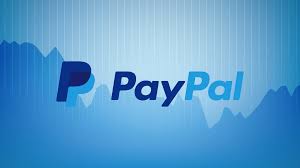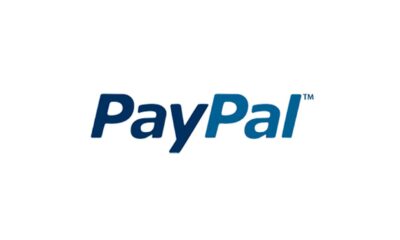Nyheter
In the Spotlight, Cheung Kong Property Holdings Ltd
Publicerad
9 år sedanden

In the Spotlight, Cheung Kong Property Holdings Ltd September 2015. SPUNdamentals provides spin-off research insights from Horizon Kinetics, LLC. The firm has produced spin-off research since 1996, and began covering international spin-offs in 2010. Horizon Kinetics Global Spin-Off Index (GSPIN), the underlying index of Market Vectors® Global Spin-Off ETF (SPUN), was launched in April 2014.
About SPUN
SPUN seeks to replicate GSPIN, a rules-based, equal-weighted index intended to track the performance of listed, publicly-held spin-offs that are domiciled and trade in the U.S. or developed markets of Western Europe and Asia.
In the Spotlight: Cheung Kong Property Holdings Ltd.
Written by Horizon Kinetics’ Research Analysts and CFA Charterholders Ryan Casey and Salvator Tiano, who bring more than 20 years of combined industry experience to their research roles focusing on domestic and international spin-offs.
Spin-Off Company: Cheung Kong Property Holdings Ltd. (Ticker: 1113 HK)
Parent Company: CK Hutchison Holdings Ltd. (Ticker: 1 HK)
Spin-off Date: June 2, 2015
GSPIN Index Inclusion Date: July 1, 2015
Cheung Kong Property Holdings Ltd. (“Cheung Kong Property”) (Ticker: 1113 HK) was spun off from CK Hutchison Holdings Ltd. (Ticker: 1 HK) in June 2015, the latter being the result of a merger between Cheung Kong (Holdings) Ltd. and its publicly traded subsidiary Hutchison Whampoa Ltd. The spin-off of Cheung Kong Property separates the real estate assets of Cheung Kong Holdings and Hutchison Whampoa from the remaining conglomerate and will create a pure-play real estate business that we believe should garner a market valuation more reflective of its asset value. The businesses of CK Hutchison Holdings will span utilities, transportation assets, telecommunications, port services, and energy. We expect Li Ka-shing, the richest man in Asia, to continue to own 30% of both entities.
Cheung Kong Property Holdings operates under four segments: property sales, property rentals, hotels and serviced suites, and property and project management. The first segment derives its revenue from the development and sale of real estate, particularly residential properties.
The property rental segment generates stable and recurring income from a portfolio of premium commercial real estate located primarily in Hong Kong. Hotels and serviced suites comprise properties in Hong Kong, China, and the Bahamas that are held for short-term leases. The company also owns equity interests in a number of publicly traded real estate investment trusts.
At the time of the spin-off, the company’s real estate portfolio was appraised at a market value of HKD420 billion,1 yet it is recorded on the balance sheet at a value of only HKD275 billion. By making this adjustment, one finds that the current share price represents a 35% discount to net asset value, thus allowing investors to purchase this real estate portfolio at an attractive price and potentially benefit from the value created by future development projects. Though the headwinds facing the Chinese economy are real and may well impact fundamentals for the China- and Hong Kong-based real estate assets, we believe the discount to net asset value at which the shares currently trade appears excessive.
1As appraised by various real estate brokers, including DTZ.
As of August 31, 2015, Cheung Kong Property Holdings Ltd. represented 1.2% of SPUN’s total net assets.
SPUNMarket Vectors Global Spin-Off ETF
Capture the Full Potential of Spin-Offs Globally
Key Features:
• Spin-off investing is an established event-driven strategy
• Global index coverage
• Early, long-term stock positions allow index to capture full spin-off cycle
SPUN Details
SPUN Details
| Fund Ticker | SPUN |
|---|---|
| Commencement Date | 6/09/2015 |
| Gross Expense Ratio1 | 0.62% |
| Net Expense Ratio1 | 0.55% |
| Distribution Frequency | Annually |
| Index Ticker | GSPIN |
| Index Rebalancing | Quarterly |
Expenses for SPUN are capped contractually at 0.55% until at least 2/01/17. Cap excludes certain expenses, such as interest.
SPUNdamentals är producerat av Van Eck och publiceras i samarbete och med tillstånd på ETFSverige.se
IMPORTANT DISCLOSURE
The views and opinions expressed are those of Horizon Kinetics’ Ryan Casey and Salvator Tiano. The views and opinions are subject to change with market conditions and do not necessarily reflect the views and opinions of Van Eck Global. The views are provided for informational purposes only, are not meant as investment advice and are subject to change.Current market conditions may not continue. Non-Van Eck Global proprietary information contained herein has been obtained from sources believed to be reliable, but not guaranteed. No part of this material may be reproduced in any form, or referred to in any other publication, without express written permission of Horizon Kinetics. Past performance is not a guarantee of future results. All economic and performance information referenced is historical and is no guarantee of future results.
Market Vectors Global Spin-Off ETF (SPUN) is not sponsored, endorsed, sold or promoted by Horizon Kinetics, LLC. Horizon Kinetics, LLC makes no representation or warranty, express or implied, to the owners of Market Vectors Global Spin-Off ETF or any member of the public regarding the advisability of investing in securities generally or in Market Vectors Global Spin-Off ETF.
The Horizon Kinetics Global Spin-Off Index (the “Index” or “GSPIN”) was created by Horizon Kinetics, parent company to Horizon Asset Management LLC and Kinetics Asset Management LLC, among others. Indxx, LLC, a third party, has a contractual arrangement with Horizon Kinetics; whereby, it has agreed to calculate certain Index components. The Index was launched in April 2014.
Nothing contained herein constitutes a solicitation to purchase or offer to sell securities or other investment products. The material herein is for informational purposes only and should not be construed as investment recommendations or investment advice. Inclusion of a security within the Index is not a recommendation to buy, sell or hold such security. Any returns or performance provided within any document or link is provided for illustrative purposes only. It is not possible to invest directly in the Index. Exposure to a specified asset class or strategy represented by the Index is only available through investable instruments based on the Index. Horizon Kinetics may receive compensation in connection with licensing the Index or through other use of the Index. There is no assurance that investment products based on the Index will accurately track index performance or provide positive investment returns. Any decision to invest in any investment fund or other vehicle should only be considered after reviewing such fund’s most recent prospectus or other disclosure document and carefully considering the risks associated such investment.
All indices listed are unmanaged indices and do not reflect the payment of transaction costs, advisory fees or expenses that are associated with an investment in the Fund. An index’s performance is not illustrative of the Fund’s performance. Indices are not securities in which investments can be made.
Fund shares are not individually redeemable and will be issued and redeemed at their Net Asset Value (NAV) only through certain authorized broker-dealers in large, specified blocks of shares called “creation units” and otherwise can be bought and sold only through exchange trading. Creation units are issued and redeemed principally in kind. Shares may trade at a premium or discount to their NAV in the secondary market.
An investment in the Fund may be subject to risks which include, among others, risks associated with spun-off companies that may have limited liquidity, pricing inefficiencies, and may be more speculative in nature than established companies, all of which may adversely affect the Fund. Foreign investments, specifically those in Europe and Asia, are subject to risks, which include changes in economic and political conditions, foreign currency fluctuations, changes in foreign regulations, and changes in currency exchange rates which may negatively impact the Fund’s return. Small- and medium-capitalization companies may be subject to elevated risks. The Fund’s assets may be concentrated in a particular sector and may be subject to more risk than investments in a diverse group of sectors.
Investing involves substantial risk and high volatility, including possible loss of principal. Bonds and bond funds will decrease in value as interest rates rise. An investor should consider the investment objective, risks, charges and expenses of the Fund carefully before investing.
To obtain a prospectus and summary prospectus, which contains this and other information, call 888.MKT.VCTR or visit vaneck.com/etf. Please read the prospectus and summary prospectus carefully before investing.
Du kanske gillar
Nyheter
Tillgång till italienska statsobligationer med fast löptid
Publicerad
19 timmar sedanden
24 april, 2024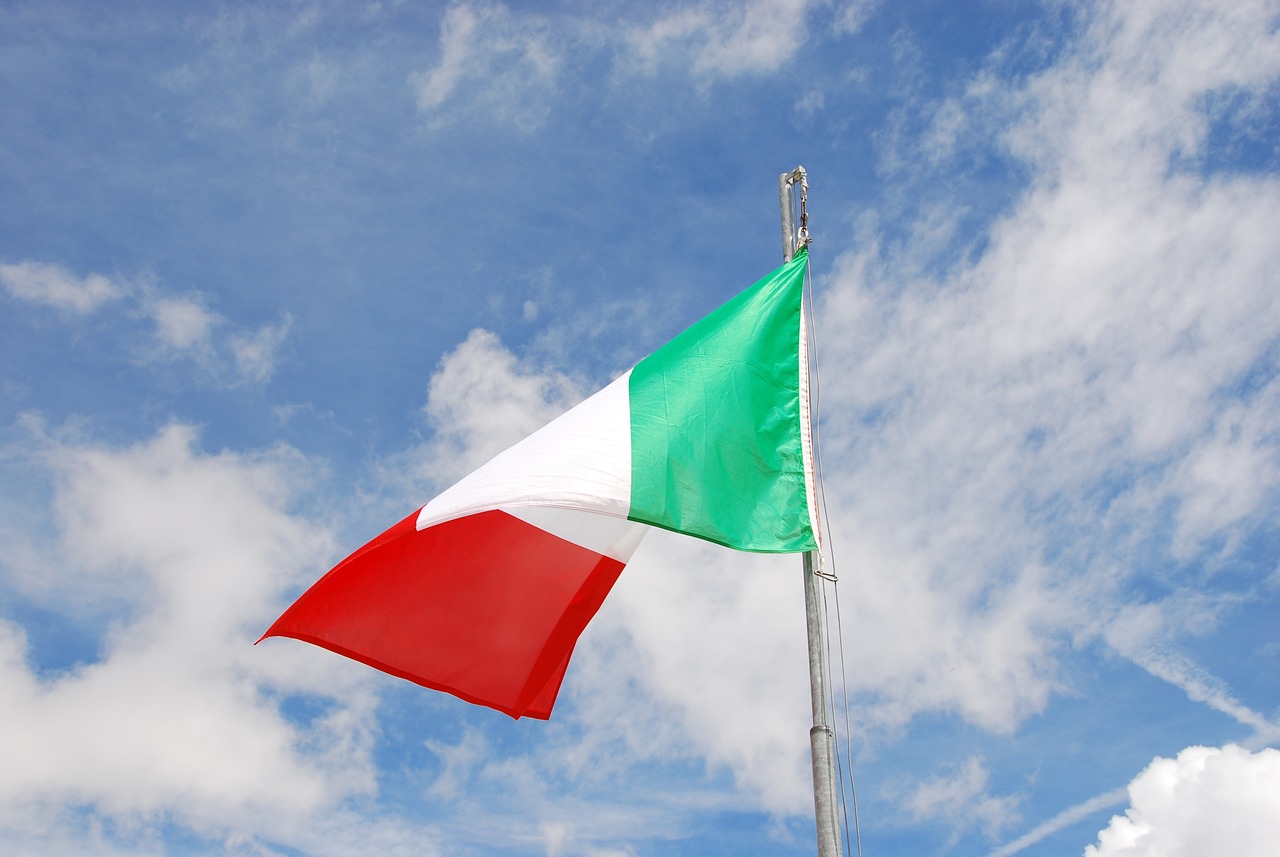
Sedan i onsdags har två nya börshandlade fonder utgivna av iShares kunnat handlas på Xetra och Börse Frankfurt. Dessa börshandlade fonder ger tillgång till italienska statsobligationer med fast löptid.
De två iShares iBonds dec 2026 och iShares iBonds dec 2028 Term € Italy Govt Bond UCITS ETFer ger investerare tillgång till en portfölj av eurodenominerade italienska statsobligationer som förfaller under samma kalenderår som ETFernas förfallodatum. Förfallodagen är satt till slutet av 2026 eller 2028. Vid löptidens slut likvideras den börshandlade fonden och portföljvärdet betalas ut till andelsägarna.
| Namn | ISIN | Avgift % | Utdelnings-policy | Referens- index |
| iShares iBonds Dec 2026 Term € Italy Govt Bond UCITS ETF (EUR) Dist) (26TP) | IE000LZ7BZW8 | 0,12 % | Utdelning | ICE 2026 Maturity Italy UCITS Index |
| iShares iBonds Dec 2028 Term € Italy Govt Bond UCITS ETF (EUR) Dist) (28IY) | IE000Q2EQ5K8 | 0,12 % | Utdelning | ICE 2028 Maturity Italy UCITS Index |
Produktutbudet i Deutsche Börses XTF-segment omfattar för närvarande totalt 2 156 ETFer. Med detta urval och en genomsnittlig månatlig handelsvolym på cirka 14 miljarder euro är Xetra den ledande handelsplatsen för ETFer i Europa.
Nyheter
Navigating Macro Headwinds, On-Chain Optics, and The Rise of Runes
Publicerad
20 timmar sedanden
24 april, 2024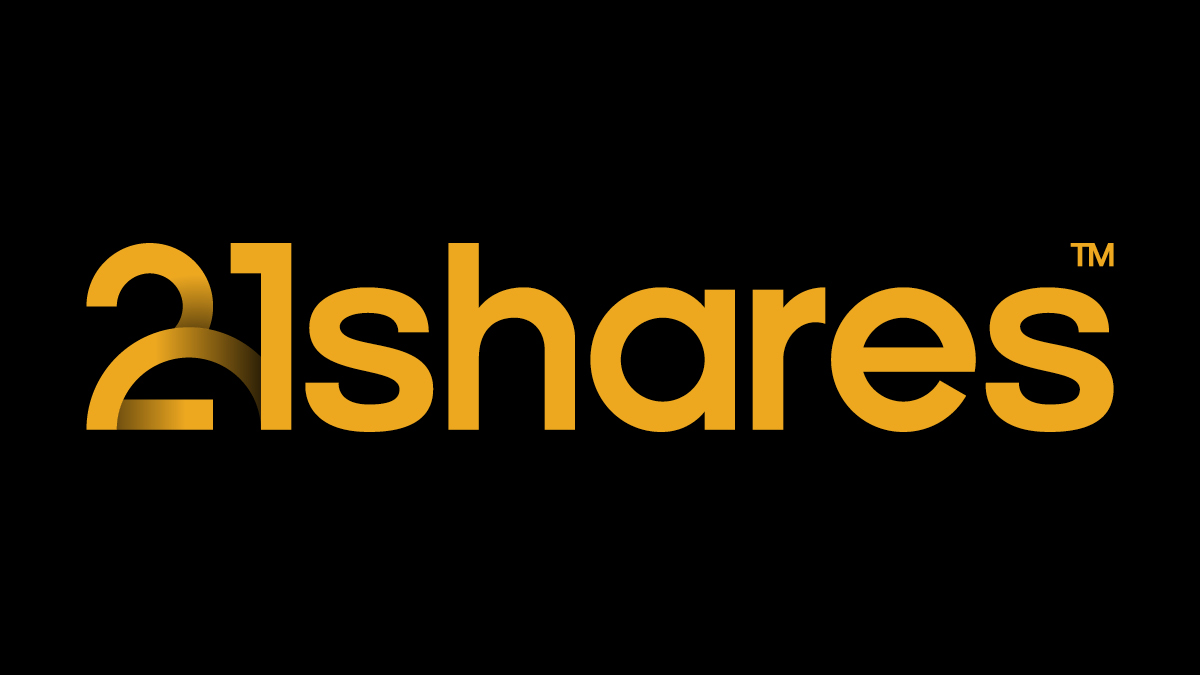
• Bitcoin Weathers Macroeconomic Storm
• Heightened User Activity, Soaring Transaction Fees, While Miners Sell Less
• Runes Protocol and Bitcoin’s Ever-Growing Ecosystem
Navigating Macro Headwinds, On-Chain Optics, and The Rise of Runes
This newsletter will be a Bitcoin-centric edition as we dissect the impact of recent macroeconomic events on Bitcoin’s price, followed up with an on-chain analysis of the network’s behavior post-halving. Additionally, we’ll explore some of the exciting innovations emerging within the Bitcoin ecosystem that were timed following the latest halving.
Bitcoin Weathers Macroeconomic Storm
The past two weeks have presented a challenging market environment for the crypto industry. As mentioned in our last newsletter, rising inflation in the U.S. remains, as evidenced by the higher-than-expected CPI print on April 9. Additionally, escalating conflict in the Middle East poses a significant threat to regional stability and added stress on the U.S. The potential of wider involvement from additional militant groups such as Lebanon’s Hezbollah, coupled with Iran’s control of a crucial maritime passage for commodity trading, the Strait of Hormuz, raise concerns about potential energy price hikes, steepening inflationary pressures and their effect on various asset classes.
Bitcoin initially reacted negatively to these events, experiencing an 8.22% drop in the immediate aftermath. Despite the 24/7 nature of crypto markets, which could have amplified the initial price shocks, Bitcoin’s underlying resilience shines through upon closer inspection. The S&P 500 fell by 2.03% on the market reopening last Monday and continues to tumble, while Bitcoin has recovered over 3.28% since the drawdowns, evidenced in Figure 1. This suggests a potentially more robust response to geopolitical turmoil compared to traditional assets, which is unsurprising given Bitcoin’s narrative as a flight to safety.
Figure 1: Bitcoin vs. Gold Price Performance Amid Geopolitical Tension
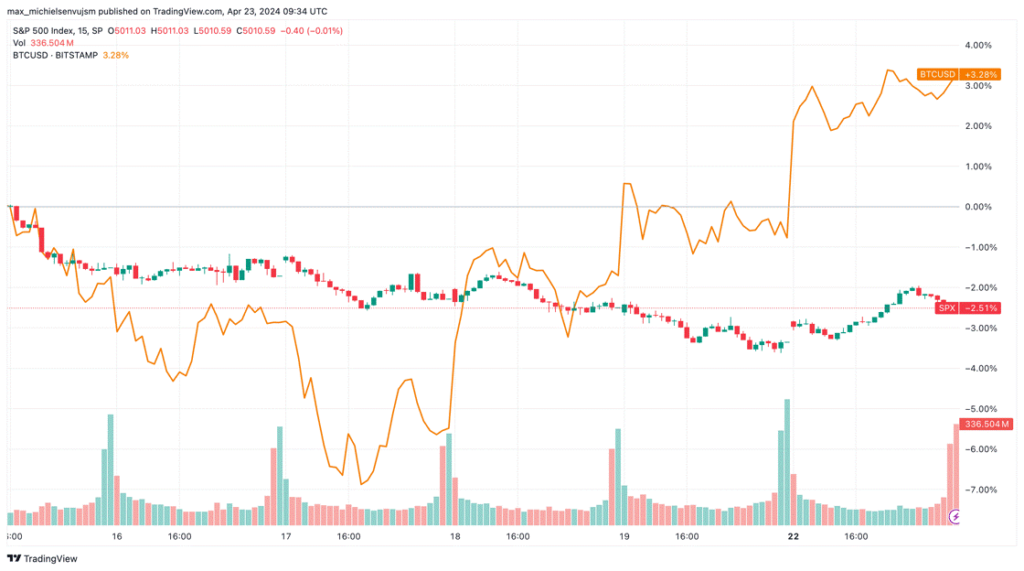
Source: TradingView
Examining Bitcoin’s market data, we see clear evidence that the futures market played a significant role in the initial price drops, which were attributed to the macroeconomic events of the last few weeks. A significant spike in long liquidations on the day of the attack, at $168M, suggests that some leveraged traders exited their positions, as shown below in Figure 2. Additionally, the high open interest at $35B leading up to the CPI print was followed by a recent $5B cool-off, indicating a correction in the futures market, reflected in the consolidation of the Bitcoin price.
Figure 2: Bitcoin Futures Long Liquidations, Short-Term and Long-Term Holder Supply
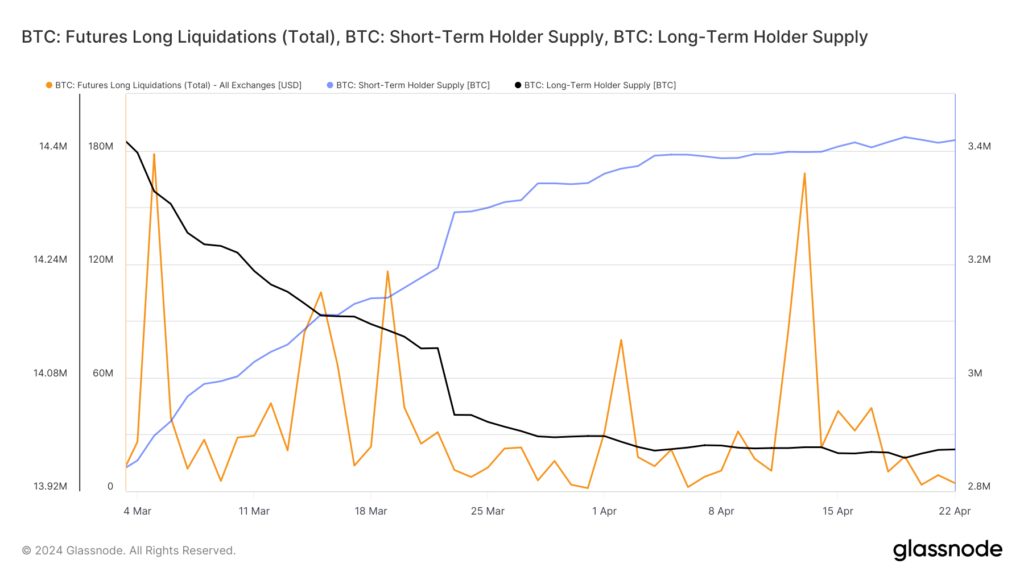
Source: Glassnode
Importantly, the spot market paints a more optimistic picture. In the last 10 days, which includes last week’s turbulence, long-term holders displayed minimal selling activity. Their holdings decreased by only 0.05%, while short-term holders continued to accumulate BTC, increasing their holdings by 0.5%. Notably, “Accumulation Addresses,” characterized by having no outbound transactions, holding more than 10 BTC, and not being affiliated with centralized exchanges or miners, have capitalized on the recent market dip. They currently hold over 3.17M BTC, accumulating over $2.3B since the CPI print, as evidenced below by Figure 3.
Figure 3 – Total Balance in Accumulation Addresses
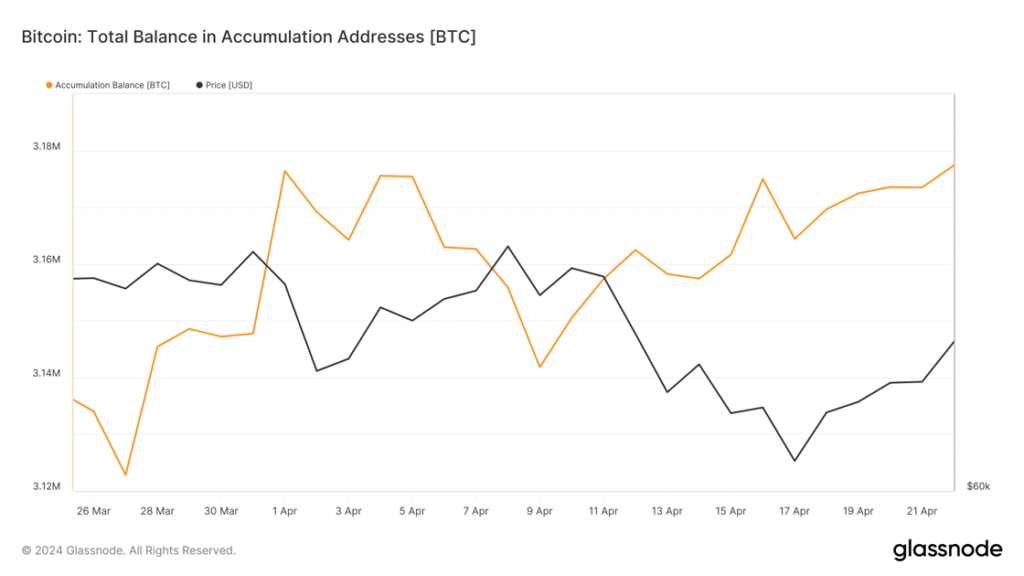
Source: Glassnode
Further bolstering the positive outlook, the 90-day due diligence period for U.S. spot Bitcoin ETFs has now concluded. According to Bloomberg, over 100 fund managers have disclosed their ownership of these products, signifying the growing institutional appetite for Bitcoin exposure, adding another layer of support to the asset class.
Heightened Activity, Soaring Transaction Fees, While Miners Sell Less
In the world of Bitcoin, transactions get logged onto a whiteboard-like structure, divided into cells called “blockspace,” where each cell represents a limited amount of space. Transaction fees play a crucial role in managing limited block space on the Bitcoin network. Users who pay higher fees get their transactions prioritized for confirmation within these blocks. This ensures smoother operation by preventing congestion and disincentivizing low-value spam transactions. Additionally, transaction fees serve as an important security measure. They incentivize miners to dedicate significant computing power to validate transactions and secure the network. Without these fees, mining might become less profitable, potentially jeopardizing network security.
Finally, transaction fees are at the core of Bitcoin’s economic sustainability as the mining reward gets halved every 210,000 blocks, transaction fees step up to fill the gap and pump miners’ revenue. We can already see the early innings of transaction fees rising against the issuance or block rewards since the launch of Ordinals in 2023, as shown in the chart below.
Figure 4 – Bitcoin Miners Revenue Breakdown
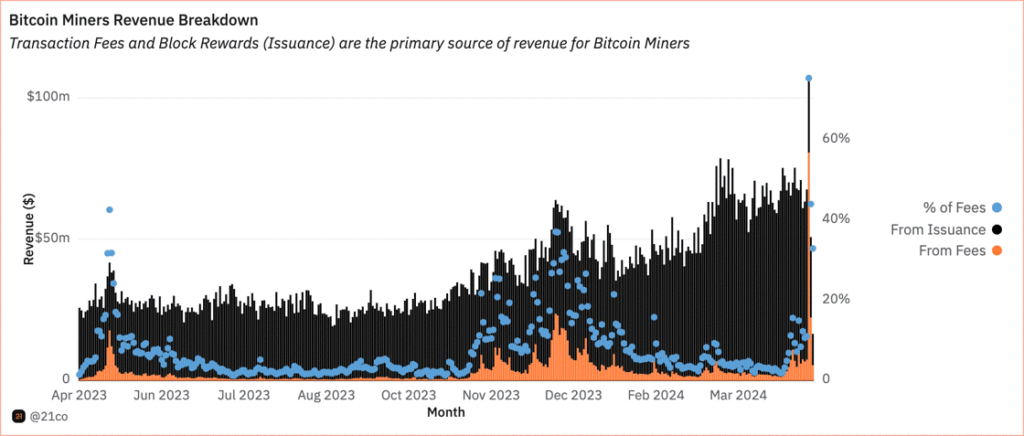
Source: 21co on Dune
It is no surprise that Bitcoin network activity has been high this year, with the amount of active addresses hovering between 700K and 1 million since January, up until the halving event. On-chain data reveals a lower-than-expected drop in active addresses following the halving, with transaction fees reaching new highs. While active addresses did experience a significant drop (43%) on April 19, falling from over 893K to 500K, they have already recovered 70K since then. Historically, the halving typically leads to a smaller decrease in active addresses (3-9%). This larger drop could indicate that rising fees are pricing some users out of the market for now, but as we’ll cover later, there are certain solutions being worked on to help alleviate this issue.
That said, transaction fees soared up to $128 on April 20, breaking $78M, tripling the previous all-time high, and making up 75% of Bitcoin miner revenue, as shown in Figure 4. The spike was primarily due to Ordinal-like inscriptions which have recently seen a spike thanks to Runes protocol, which we’ll delve deeper into in the last section. In line with this, the burgeoning Bitcoin ecosystem, expedited by Rune, has not only pushed Bitcoin out of its comfort zone unlocking new use cases, but also its transaction fees to surpass Ethereum’s since May 2023, as seen in Figure 5.
Figure 5 – BTC vs ETH fees (2 Years)
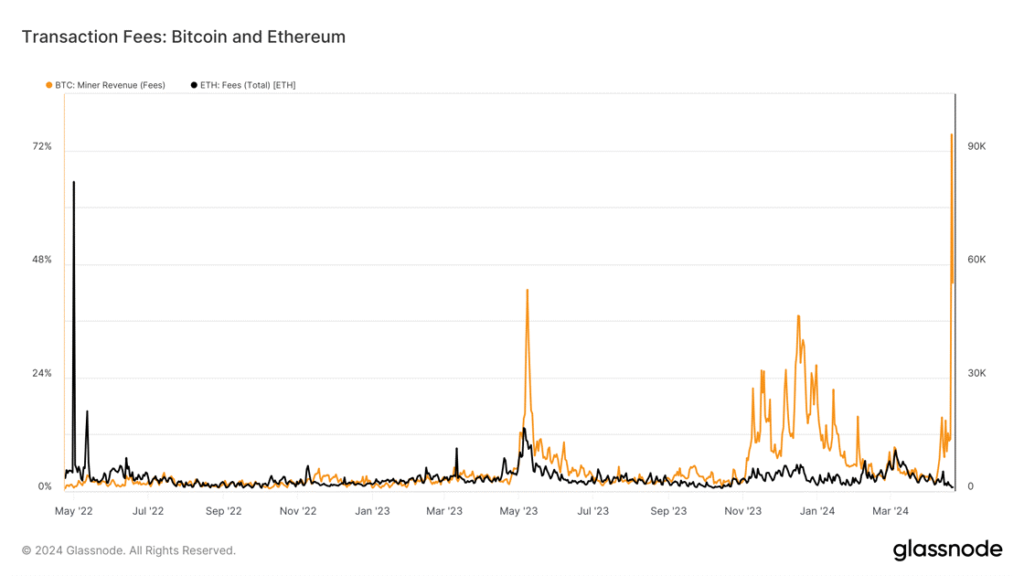
Source: Glassnode
The growth in transaction fees is appreciated even further, especially when we examine miner behavior following the halving event. Miners are now less motivated to immediately liquidate their freshly acquired BTC, as they can capitalize on an additional revenue stream apart from block rewards.
Let’s zoom in on miner activity after the halving. About 50 BTC were sold on centralized exchanges on April 20, which doesn’t compare to the sell-off of March 5 when approximately 1,154 BTC were sent to exchanges, pulling the asset to ~$64K, down from ~$68K, as shown in the chart below. The recent sale also doesn’t compare to the 307 BTC sold on the day following the previous halving in May 2020, when the asset was trading just below $9K.
Figure 6 – Transfer Volume from Bitcoin Miners to Exchanges in BTC (YTD)
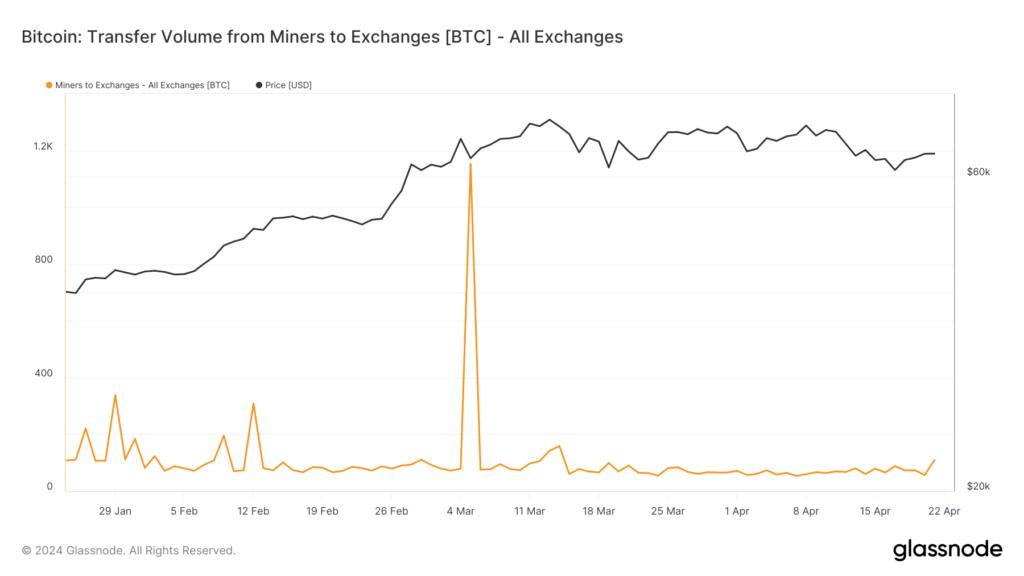
Source: Glassnode
The rising importance of Ordinal inscription, akin to non fungible tokens (NFTs), can be seen with Bitcoin generating $475M in real NFT sales versus Ethereum, which helps miners rake in more revenue and become sustainable. That said, the growing adoption of the Runes protocol is expected to drive even more activity toward the miners over the coming months.
Runes Protocol and Bitcoin’s Evergrowing Ecosystem
To recap, Runes streamlines the creation and management of fungible tokens on top of Bitcoin. It addresses the inefficiencies of the BRC20 standard, which have burdened the Bitcoin blockchain due to its inefficient data handling approach. That said, Runes achieves this in two key ways. Firstly, it optimizes transaction fees by consolidating multiple Unspent Transaction Output (UTXO) transactions into one bundle, leveraging Bitcoin’s accounting UTXO model. Additionally, it utilizes Bitcoin’s script, OP_Return, to inscribe data directly onto the blockchain, which serves to assign and transfer Runes balances within the network’s UTXOs. By minimizing data usage to 80 bytes, compared to BRC20’s 4MB, Runes prevents unnecessary bloat on the Bitcoin blockchain.
Ultimately, Runes presents an innovation aimed at bolstering Bitcoin’s security budget, offering miners an alternative revenue source to reduce their dependence on Bitcoin’s subsidized rewards over the long term. In fact, miners have earned about 1,500 BTC, valued at close to $100M in less than three days of trading activity, as seen below in Figure 7. To that end, Runes has garnered widespread support from the outset, with multiple Tier 2 exchanges such as OKX and Gate.io already announcing the listing of early collections like UNCOMMON.GOODS and MEME.ECONOMICS, which were among the first collections minted. Additionally, Binance appears to be hinting at support for meme tokens like Wizard and Pups, which were also among the first tokens to migrate from the BRC20 to the Runes standard. Meanwhile, NFT platforms like Magic Eden and Bitcoin-focused wallet provider Unisat are also joining the trend to capitalize on Runes’ growing popularity.
Figure 7: Fees Paid by Users to Mint Tokens Using the New Runes Protocol
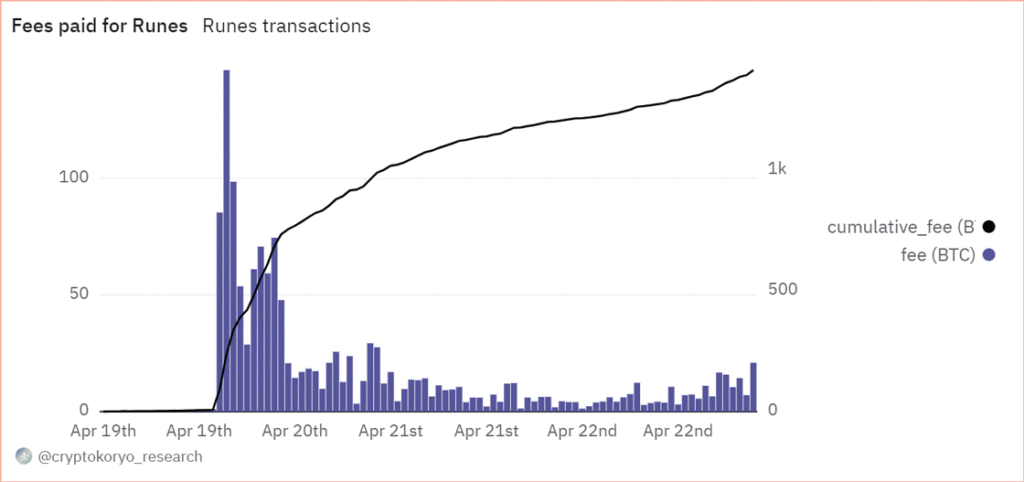
Source: CryptoKoryo on Dune
Following the pattern of past hype cycles, we anticipate that the initial excitement surrounding Runes will gradually subside, followed by a surge of heightened activity in the long run. This trend is often observed because the initial wave of interest tends to be on meme tokens, which can be quickly deployed and attract the masses’ attention, but often don’t add substantial value. However, as time progresses, sophisticated primitives like exchanges, automated market makers, and other DeFi lego blocks will begin emerging. These advancements will bolster Bitcoin’s capabilities at the application layer, streamlining the process of token trading on the Bitcoin network, much like ERC20/ERC721 did for Ethereum. In fact, when considering Bitcoin’s untapped market potential to establish its own fungible market ecosystem compared to other smart contract platforms, it becomes evident that there is substantial room for growth for this new generation of tokens, as illustrated in Figure 8 below.
Figure 8: The Market Opportunity for Bitcoin’s Fungible Tokens Ecosystem
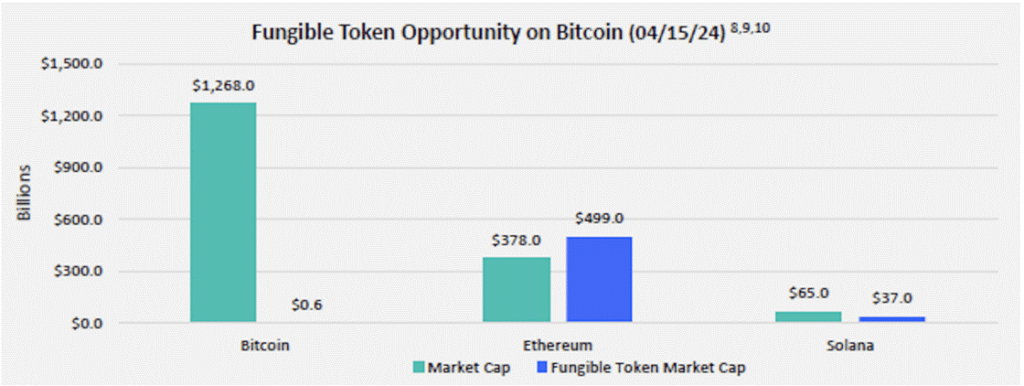
Source: FranklinTempleton
That said, Ordinals and Runes aren’t the only source of excitement pushing the boundaries of Bitcoin. For one, Bitcoin’s scaling solution Stacks began the first phase of its Nakamoto upgrade, called the instantiation stage, on April 22, while its final phase is expected to culminate by the end of May. As part of the upgrade, Stacks will introduce faster block processing times, enabling transactions to be finalized in under 5 seconds, a significant improvement from Bitcoin’s average of 10-30 minutes. Additionally, Stacks will leverage Bitcoin’s robust security guarantees, making transaction reversals on the Stacks network as challenging as those on the Bitcoin network. Furthermore, the upgrade will introduce a 1:1 BTC-backed asset (sBTC), enhancing the utility of Bitcoin by enabling its use across a diverse ecosystem of financial and gaming applications built on top of the scaling solution. The growing excitement surrounding its upgrade has pushed the total valued locked on the network to its highest point last week, reaching $170M.
On the other hand, there is a growing ecosystem of scaling solutions emerging on the back of BitVM, released last year. Standing for Bitcoin Virtual machine, this primitive is an operating system that allows for native smart-contract functionality on top of Bitcoin. It does so by introducing what’s known as a two-party provider verifier model that allows for complex computation to be executed off-chain, which can then be challenged on top of Bitcoin using fraud proofs, akin to how Arbitrum and Optimism function. To put it simply, BitVM enables Bitcoin to host more complex applications, which is giving birth to an embryonic L2 landscape, including Chainway, BitLayer, and Bob, amongst others, aiming to alleviate the issue of rising transaction costs. However, we will be closely monitoring this emerging sector, as there are numerous projects attempting to exploit the unprecedented enthusiasm for Bitcoin to launch potentially fraudulent protocols.
Bookmarks
Have you read our latest report, The Bitcoin Halving and Beyond? Click here to get a digital copy.
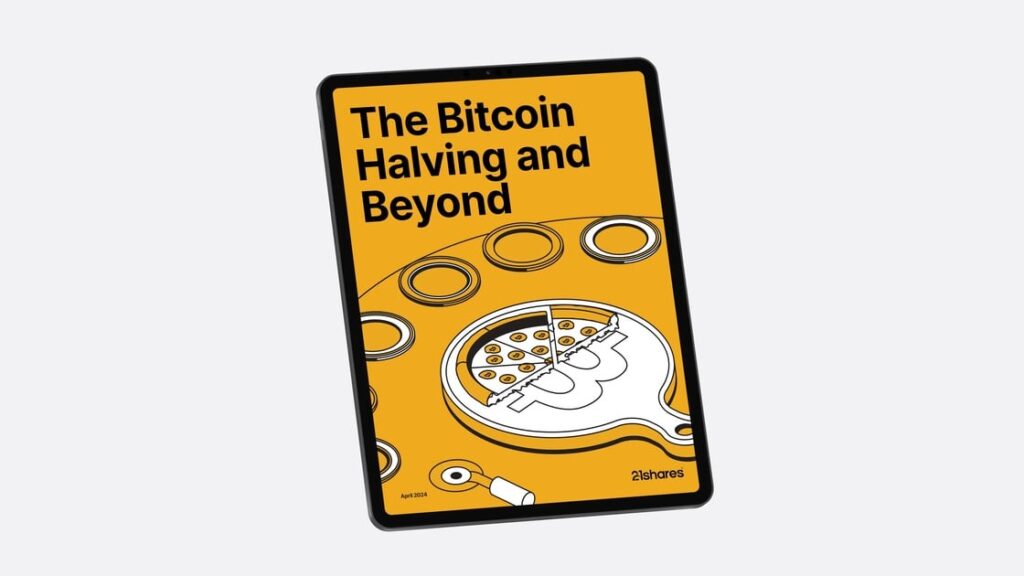
This Week’s Calendar
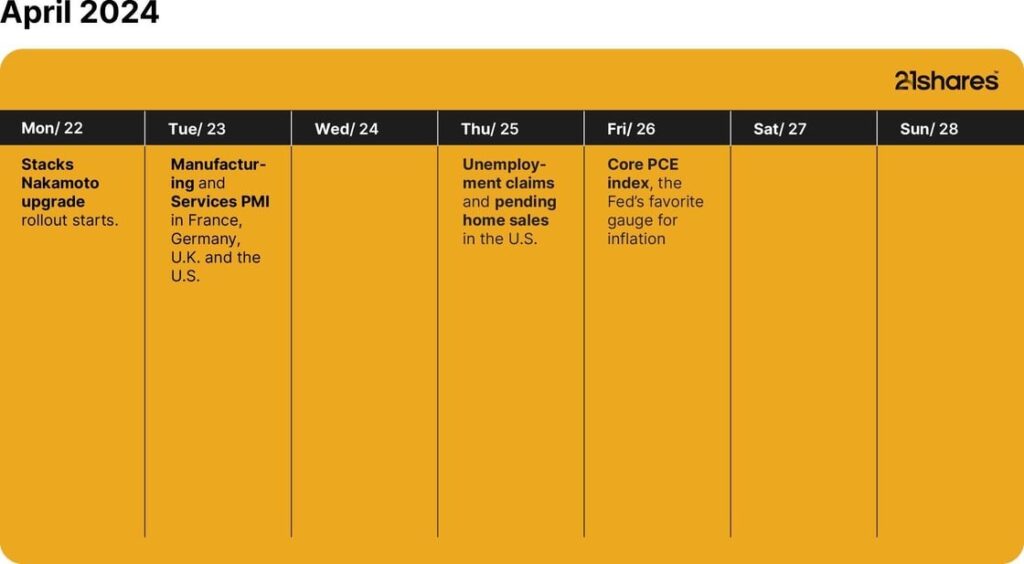
Source: Forex Factory, 21Shares
Research Newsletter
Each week the 21Shares Research team will publish our data-driven insights into the crypto asset world through this newsletter. Please direct any comments, questions, and words of feedback to research@21shares.com
Disclaimer
The information provided does not constitute a prospectus or other offering material and does not contain or constitute an offer to sell or a solicitation of any offer to buy securities in any jurisdiction. Some of the information published herein may contain forward-looking statements. Readers are cautioned that any such forward-looking statements are not guarantees of future performance and involve risks and uncertainties and that actual results may differ materially from those in the forward-looking statements as a result of various factors. The information contained herein may not be considered as economic, legal, tax or other advice and users are cautioned to base investment decisions or other decisions solely on the content hereof.
Nyheter
WisdomTree utökar sortimentet med US Quality Growth UCITS ETF (QGRW)
Publicerad
21 timmar sedanden
24 april, 2024
WisdomTree har igår lanserat WisdomTree US Quality Growth UCITS ETF (QGRW). QGRW strävar efter att spåra pris- och avkastningsutvecklingen, före avgifter och utgifter, för WisdomTree US Quality Growth UCITS Index (”Indexet”) och har en total kostnadskvot (TER) på 0,33 %. QGRW, som idag är noterat på Börse Xetra och Borsa Italiana, kommer att noteras på Londonbörsen den 24 april 2024.
Det proprietära indexet är utformat för att spåra resultatet för amerikanska storbolag med stark kvalitet (t.ex. hög lönsamhet) och tillväxtegenskaper som uppfyller WisdomTrees ESG-kriterier (miljö, social och styrning).
WisdomTrees tillvägagångssätt syftar till att ge högre uppåtdeltagande på tjurmarknader och generera positiv överavkastning över en hel marknadscykel. Tillväxtfaktorn syftar till att fånga företag som upplever tillväxt i försäljning, realiserade intäkter och förväntade intäkter, ofta inklusive disruptiva företag och tekniska jättar, vilket möjliggör större deltagande uppåt. Kvalitetsfaktorn ger stabilitet till en portfölj och hjälper till att filtrera bort de mest olönsamma, mycket spekulativa och lågkvalitativa namnen. Denna kombination positionerar WisdomTree US Quality Growth UCITS ETF som en strategisk, långsiktig aktielösning för investerare som letar efter genomtänkt exponering mot tillväxtsegmentet på den amerikanska aktiemarknaden utan att offra kvaliteten på sin portfölj.
Pierre Debru, chef för Quantitative Research & Multi Asset Solutions, WisdomTree, sa: ”Tillväxt tenderar att fånga störande och växande företag, vilket leder till högre allokering till tekniska jättar, men historisk avkastning tyder på att investeringar i tillväxtaktier utan filter kan vara en förlora spel på lång sikt. Att tillämpa en kvalitetsskärm på tillväxtaktier kan hjälpa till att säkerställa att portföljbolagen är sunda och kan leverera resultat över tid. Tillväxtaktier av hög kvalitet har historiskt sett varit bättre på att hjälpa investerare att klara avdrag än en ren tillväxtallokering utan att offra förmågan att delta i marknadsåterhämtning. Den nya ETF:n är ett alternativ till tillväxtstrategier som Nasdaq 100, eftersom den tar ett mer holistiskt tillvägagångssätt för portföljkonstruktion istället för att enbart fokusera på marknadsvärde för beståndsdelar eller deras börsnotering.”
Europeiska investerare kan nu få tillgång till QGRW, som redan är en tillgänglig strategi i USA, som initialt lanserades 2022. WisdomTree US Quality Growth UCITS ETF kommer att ansluta sig till WisdomTrees sortiment av 360 miljoner USD av Quality Growth ETFer.
Genom WisdomTree US Quality Growth UCITS ETF kan investerare fortsätta att dra nytta av WisdomTrees stilkonsekventa, transparenta och systematiska investeringsprocess med rötter i akademiskt driven forskning.
Alexis Marinof, Europachef, WisdomTree, tillade: ”Sedan WisdomTree grundades har vi fokuserat på att lansera differentierade och mervärdesinvesteringslösningar för våra kunder. Kärnan i vår aktiefilosofi är tron att kvalitetsaktier bör vara hörnstenen i varje aktieportfölj. De är avgörande för att bygga motståndskraftiga portföljer som kan hjälpa investerare att bygga upp välstånd på lång sikt och navigera i de oundvikliga stormarna. Vi vet att investerare positionerar portföljer för att dra nytta av de kommande räntesänkningarna i USA, vilket förväntas bli en positiv katalysator för tillväxtorienterade amerikanska aktier. Men som vi har sett de senaste åren utlovas ingenting på finansmarknaderna. Så, genom att fokusera på kvalitet snarare än börsvärde, kan investerare dra nytta av ett mer robust tillvägagångssätt än marknadsvärdevägda tillväxtfonder, utan att offra avkastningen på uppåtgående marknader.”
ETF information
| Namn | Avgift | Börs | Valuta | Kortnamn | ISIN |
| WisdomTree US Quality Growth UCITS ETF – USD Acc | 0.33% | London Stock Exchange | USD | QGRW | IE000YGEAK03 |
| WisdomTree US Quality Growth UCITS ETF – USD Acc | 0.33% | London Stock Exchange | GBx | QGRP | IE000YGEAK03 |
| WisdomTree US Quality Growth UCITS ETF – USD Acc | 0.33% | Borsa Italiana | EUR | QGRW | IE000YGEAK03 |
| WisdomTree US Quality Growth UCITS ETF – USD Acc | 0.33% | Börse Xetra | EUR | QGRW | IE000YGEAK03 |

Tillgång till italienska statsobligationer med fast löptid

Navigating Macro Headwinds, On-Chain Optics, and The Rise of Runes

WisdomTree utökar sortimentet med US Quality Growth UCITS ETF (QGRW)

SJPD ETF köper alla slags japanska aktier

Franklin Templeton lanserar ny fond som följer katolska principer

ETFmarknaden i Europa firar sitt 24-årsjubileum med tillgångar på två biljoner USD

De mest populära börshandlade fonderna mars 2024

3 ETF:er du nog inte visste finns

FUIG ETF investerar i hållbara företagsobligationer som följer Parisavtalet

Tillgång till obligationsmarknaden för företagsobligationer från utvecklade marknader
Populära
-

 Nyheter1 vecka sedan
Nyheter1 vecka sedanETFmarknaden i Europa firar sitt 24-årsjubileum med tillgångar på två biljoner USD
-

 Nyheter4 veckor sedan
Nyheter4 veckor sedanDe mest populära börshandlade fonderna mars 2024
-

 Nyheter4 veckor sedan
Nyheter4 veckor sedan3 ETF:er du nog inte visste finns
-

 Nyheter3 veckor sedan
Nyheter3 veckor sedanFUIG ETF investerar i hållbara företagsobligationer som följer Parisavtalet
-

 Nyheter1 vecka sedan
Nyheter1 vecka sedanTillgång till obligationsmarknaden för företagsobligationer från utvecklade marknader
-

 Nyheter2 veckor sedan
Nyheter2 veckor sedanFörsvarsfond når förvaltad volym på 500 MUSD
-
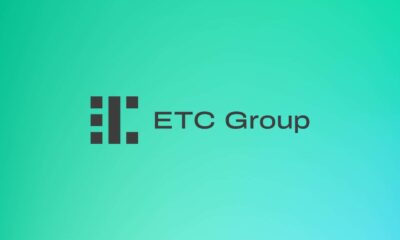
 Nyheter3 veckor sedan
Nyheter3 veckor sedanVad händer härnäst för Bitcoin?
-

 Nyheter3 veckor sedan
Nyheter3 veckor sedanNy börshandlad fond från Deka ger tillgång till S&P 500-index










